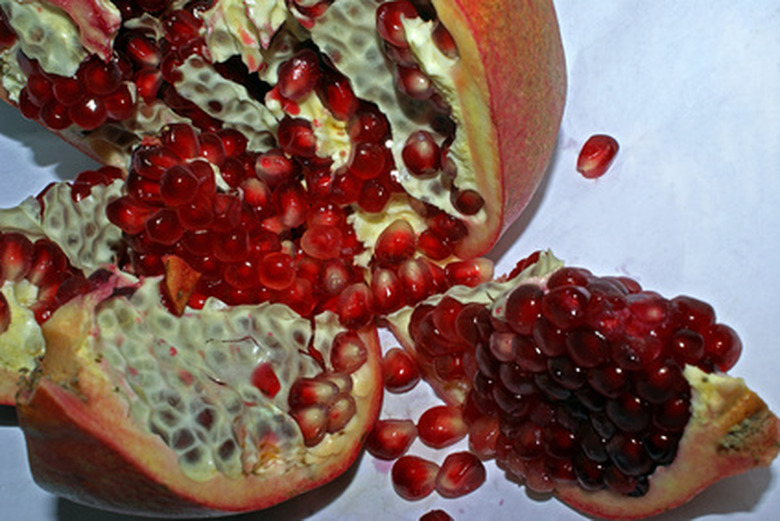Varieties Of Pomegranate Trees
The word pomegranate means "seeded apple" in old French, an apt name for a fruit that is apple-sized and contains small ruby-like clusters of red, edible seeds. Pomegranate cultivation is mainly done in India, Germany and Spain; however, the plant is a native to the Himalayan region of Northern India that later became naturalized to the Mediterranean region. A vast number of pomegranate cultivars or hybrids are presently cultivated all over the world. According to California Rare Fruit Growers, Inc., the fruit was introduced in California in 1769 by Spanish settlers.
Balegal
The balegal variety of pomegranate traces back its roots to San Diego, Calif. Balegal is an exotic fruit loaded with nutrients and vitamins like vitamin C, vitamin B, folic acid and potassium. The fruit is large and round, generally 3 to 4 inches in size. This particular variety of pomegranate's skin is pale pink and the seeds are deep red and fleshy. It is generally larger than the other varieties, like Fleshman and Green Globe. Take care that the soil in which it is planted is pH neutral or slightly acidic for optimal growth. The plant prefers a sunny climate for optimal growth and yield.
- The word pomegranate means "seeded apple" in old French, an apt name for a fruit that is apple-sized and contains small ruby-like clusters of red, edible seeds.
Early Wonderful
The early wonderful variety of pomegranate is rated as the best for its yield value, according to California Rare Fruit Growers, Inc. Early wonderful has a large fruit that is preferred by orchards and home garden owners due to its consistent cropping. The fruit contains a large amount of vitamin C, niacin and fiber. Early wonderful should be planted in a soil having excellent internal drainage and must be watered continuously during planting. It can grow in all sorts of weather, including tropical, temperate and subtropical regions. The plant may undergo severe fruit drop in initial years but will recover on its own.
Fleshman
The Fleshman variety of pomegranate has fruits that grow up to 2.5 inches in diameter. The seeds and the skin are pink rather than deep red when ripe. Though the plant is less productive than the other varieties, this variety is still preferred by gardeners and orchard owners for the quality of the fruit it produces. The plant is tough to cultivate in domestic settings because fleshman requires special care in terms of time-to-time spraying of fertilizers and specific climatic conditions. The fruit is quite soft and sweet in taste and requires an application of 2 to 4 ounces of ammonium sulfate during first two years for best growth.
- The early wonderful variety of pomegranate is rated as the best for its yield value, according to California Rare Fruit Growers, Inc.
- Early wonderful has a large fruit that is preferred by orchards and home garden owners due to its consistent cropping.
- The fruit is quite soft and sweet in taste and requires an application of 2 to 4 ounces of ammonium sulfate during first two years for best growth.
Green Globe
The green globe variety is called so because it generally remains a tad greenish as compared to other varieties, even when fully ripe. This cultivar originated in Camarillo, Calif. Green globe is known for its antioxidant properties and also is used in the manufacture of vodka and red wine. The fruit produced by the green globe variety grows up to 3 inches and has its own distinct aroma. The plant grows in any general type of soil and requires a sunny climate. Green globe starts producing fruits the second or third year after it is planted.
